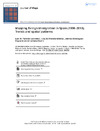Please use this identifier to cite or link to this item:
https://accedacris.ulpgc.es/jspui/handle/10553/77319
| Title: | Mapping foreign immigration in Spain (1998–2018). Trends and spatial patterns | Authors: | Parreño Castellano, Juan Manuel Moreno Medina, Claudio Jesús Domínguez Mujica, Josefina Santana Rivero, Cecilia |
UNESCO Clasification: | 540302 Demogeografía | Keywords: | Economic Crisis Foreign Immigration Foreign Ratio Location Coefficient Multivariate Analysis, et al |
Issue Date: | 2021 | Project: | Vivienda y movilidad internacional en las ciudades insulares. La aparición de nuevas formas de desigualdad urbana. | Journal: | Journal of Maps | Abstract: | The last 20 years of sociodemographic history in Spain cannot be interpreted without considering the impact of foreign immigration, numerous publications have shown. The aim of this article is to contribute a clear spatial representation of migrants in Spain by combining statistical and mapping methods. Maps showing the rate of variation of immigrant populations point to the existence of an uneven distribution around Spain, during both the period of economic growth and the years when migratory flows waned. On the other hand, the immigrant clusters show that certain geographic areas in Spain attract specific groups; the extent of their presence can be seen on density maps based on location coefficients. In short, this article provides an understanding of foreign immigration in Spain, which other approaches have not achieved. | URI: | https://accedacris.ulpgc.es/handle/10553/77319 | DOI: | 10.1080/17445647.2020.1866700 | Source: | Journal of Maps [EISSN 1744-5647], v. 17(1), p. 78-83, (Enero 2021) |
| Appears in Collections: | Artículos |
SCOPUSTM
Citations
6
checked on Jun 8, 2025
WEB OF SCIENCETM
Citations
4
checked on Jun 8, 2025
Page view(s)
167
checked on Nov 1, 2024
Download(s)
178
checked on Nov 1, 2024
Google ScholarTM
Check
Altmetric
Share
Export metadata
Items in accedaCRIS are protected by copyright, with all rights reserved, unless otherwise indicated.
